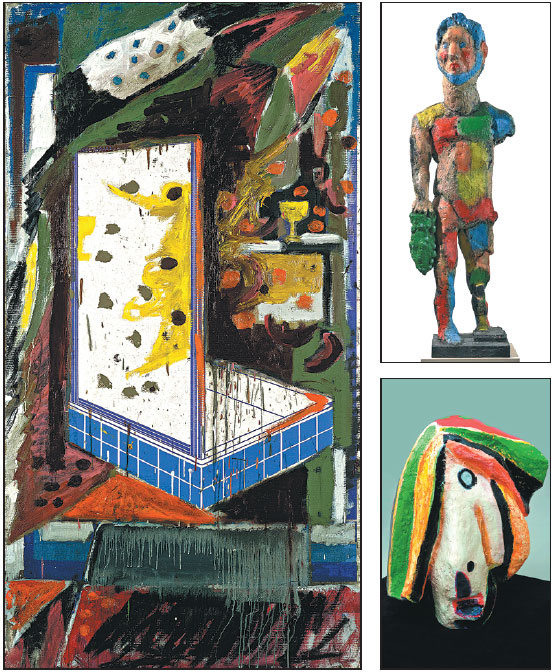Lupertz effect
By Lin Qi (China Daily) Updated: 2017-04-11 07:59|
Markus Lupertz's current exhibition at Tsinghua University Art Museum shows his paintings and sculptures of different periods, beginning from the Dithyrambe series of paintings in 1962 to the latest Arcadia series. Photos Provided to China Daily |
Tsinghua University Art Museum holds first solo exhibition of a living artist with German neo-expressionist's works. Lin Qi reports.
Since its official opening in September, Tsinghua University Art Museum is presenting its first solo exhibition of a living artist.
From Dithyrambe to Arcadia shows 88 paintings and 16 sculptures of German neo-expressionist Markus Lupertz.
It is not Lupertz's first communication with Chinese audience. People here know the 76-year-old artist through his large pieces that are often characterized by rough strokes and vivid colors.
In 2015, Return of Western Paintings, an exhibition of his creations over the past decade toured Beijing and Guangzhou.
The ongoing show in Beijing reiterates his long-term pursuit to present the character of divinity of painting, even as more artists today work with mixed media or employ digital technology.
It includes his many series over a 50-year career, starting from the Dithyrambe series of paintings in 1962 to the Arcadia series he began in 2011.
"Painting is spiritual. It is a dream that surpasses many image processing technologies," says Lupertz.
Feng Yuan director of the Tsinghua museum says although neo-expressionist works were first introduced to China in the late 1980s and early '90s, and influenced many homegrown artists, the style remains unfamiliar to general audiences. He hopes Lupertz's works will bring the style, which emerged in the 1970s in reaction to pop-art and minimalism, closer to Chinese viewers.
His repertoire on show begins with his paintings from the 1960s, after he moved to Berlin and was inspired by German philosopher Friedrich Nietzsche's theories on poetry. Then it moves to his German motifs series in the following decade in which he reflected upon World War II. His use of certain objects that symbolize the Nazi period aroused debates at the time.
His works of the 1980s show a marked shift in his practice: He became interested in Greek myths and he began making sculptures. In 1988, he was appointed the dean of Dusseldorf Academy of Fine Arts, which has produced many internationally notable artists. He stayed in that position until 2009, during which time he continued his experiments with painting.
The latest Arcadia series of paintings on show is one of his prolific endeavors after leaving the academy in the German city of Dusseldorf. Unlike his earlier works, they feature a moderate palette to demonstrate his philosophical thoughts on reality and mournful resonance with the past of human society.
Lupertz, who inaugurated his own exhibition at Tsinghua on March 27, says the show is also a chance for him to "retrace" his youth, especially the energy with which he worked. He wants to keep going for "another 20 years", he says.
Looking at the works on display, he feels both "happiness and strangeness of reunion", and they enable him to review his "ideals to persist with painting".
Calling painting an age-old skill, Lupertz says, "This trade of antiquity produces generations of artists. At a time when machines have replaced many handmade skills, making it more convenient to create images, many artists still paint."
He adds that while painting brings misery to artists, because they often don't feel satisfied with their work and destroy their own creations with the same hands that created them. But even in such moments, instances of delight keep artists like himself going, which is why he would not abandon art.
The process of discovery of new approaches to painting is also to "release one from the control of advancing technology, and therefore, gain the freedom to imagine".
"If artists never stop racking their brains, painting will not lose its divinity," he says.
Lupertz's exhibition has an "exclusive" German sponsor, Bell Art Centre, an institution that has been active in exhibiting Western art in China in recent times.
All shown works come from a private German collection called the MAP Collection. It was one of the two sources of works shown at Anselm Kiefer Coagulation, an exhibition dedicated to the art of Anselm Kiefer, 72, also a German neo-expressionist representative, held from November to January in Beijing. The Bell Art Centre was one of the organizers.
But Kiefer himself didn't attend the exhibition as he said in a statement that it was organized without his permission or involvement. His disapproval was supported by several influential international galleries representing his works, such as the Gagosian and the White Cube.
At the opening of his Tsinghua show, Lupertz said the shown works speak from "the perspective of a single collection", implying they are not encompassing of all his oeuvre. That apart, he seemed to be enjoying his trip to China. He held a dialog with the elite university's art and design students, and even played the piano. He visited the workshops of several professors too.
He says he doesn't want to be an ardent lecturer here but instead, he "looks for nutrition from Chinese cultural traditions".
"China has excellent art, and there is no need to build an internationalized standard for painting," he says.
"When one keeps discovering inner energies of painting, his works will create extensive influence worldwide."
Contact the writer at linqi@chinadaily.com.cn
- 'Cooperation is complementary'
- Worldwide manhunt nets 50th fugitive
- China-Japan meet seeks cooperation
- Agency ensuring natural gas supply
- Global manhunt sees China catch its 50th fugitive
- Call for 'Red Boat Spirit' a noble goal, official says
- China 'open to world' of foreign talent
- Free trade studies agreed on as Li meets with Canadian PM Trudeau
- Emojis on austerity rules from top anti-graft authority go viral
- Xi: All aboard internet express












